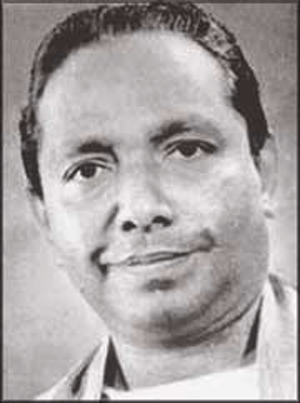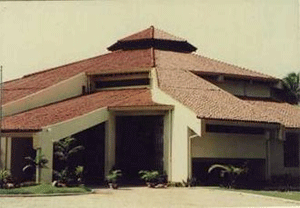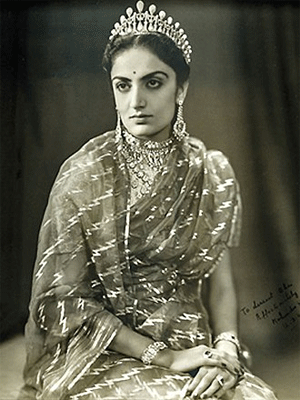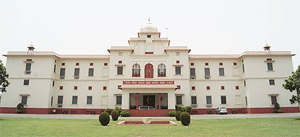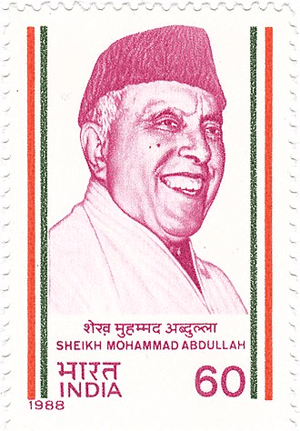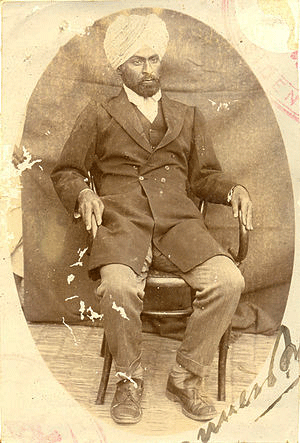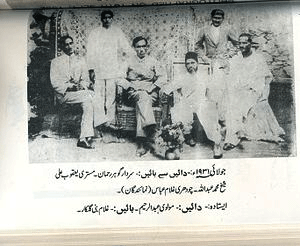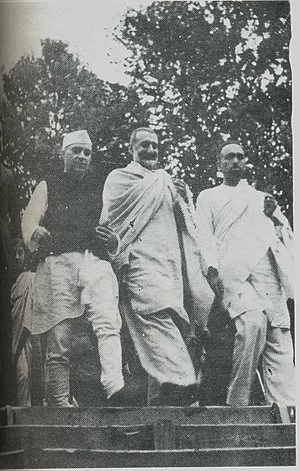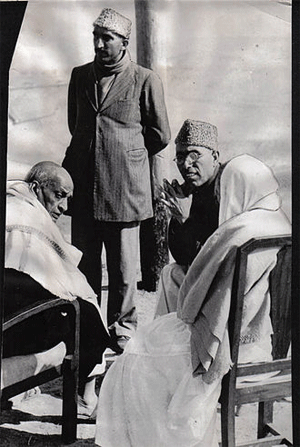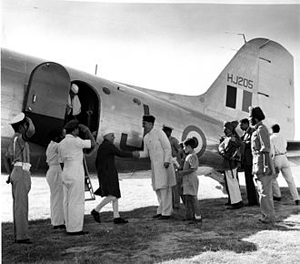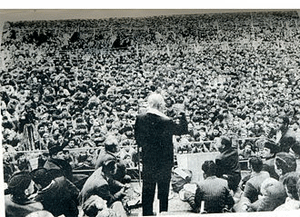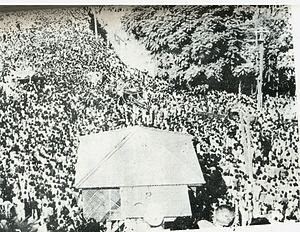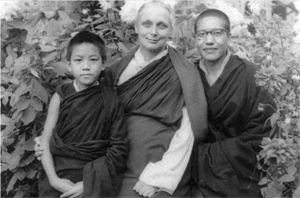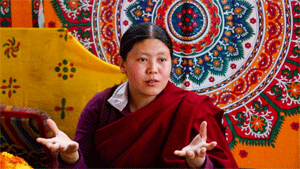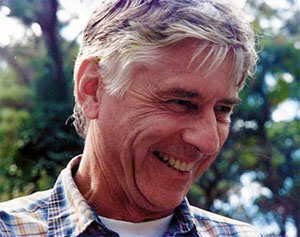Re: Freda Bedi, by Wikipedia
Maha Bodhi Society
by Wikipedia
Accessed: 4/1/19
NOTICE: THIS WORK MAY BE PROTECTED BY COPYRIGHT
The Maha Bodhi Society is a South Asian Buddhist society founded by the Sri Lankan Buddhist leader Anagarika Dharmapala and the British journalist and poet Sir Edwin Arnold. The organization's self-stated initial efforts were for the resuscitation of Buddhism in India, and restoring the ancient Buddhist shrines at Bodh Gaya, Sarnath and Kushinara.[1][2][3]
Although some Indians had remained culturally Buddhist for centuries after the decline of Buddhist philosophy, they did not self-identify as "Buddhist". The Maha Bodhi Society renewed interest in Buddhism, and spawned the Ladakh Buddhist Association, All Assam Buddhist Association, and Himalayan Buddhist Society, as well as laying the grounds for the Dalit Buddhist movement.[4]
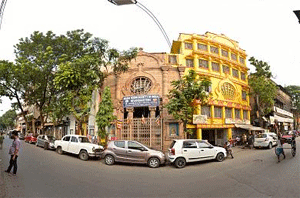
Headquarters, Maha Bodhi Society of India, Kolkata. October 2014.
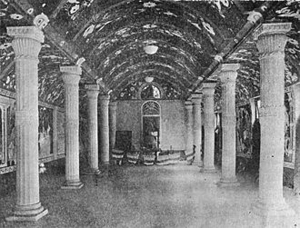
Interior of the Dharmarajika Chetiya Vihara of the Mahabodhi Society, officially opened 26th Nov 1920.
Origins
In 1891, while on pilgrimage to the recently restored Mahabodhi Temple at Bodh Gaya, the location where Siddhartha Gautama (the Buddha) attained enlightenment, Anagarika Dharmapala had experienced a shock to find the temple in the hands of a Saivite priest, the Buddha image transformed into a Hindu icon and Buddhists barred from worship as a result of which he began an agitation movement.[5] Prior to that, in 1885 Sir Edwin Arnold visited the site and published several articles drawing the attention of the Buddhists to the deplorable conditions of Buddhagaya.[1][2][3] The Buddhist renaissance inaugurated by Anagarika Dharmapala through his Mahabodhi Movement has also been described as "conservative" for it considered Muslim conquest in the Indian subcontinent responsible for the decay of Buddhism in India, in the then current mood of Hindu-Buddhist brotherhood.[6]
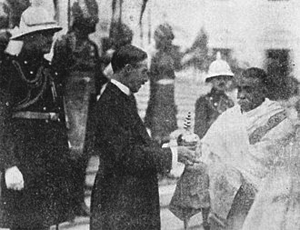
Lawrence Dundas, Lord Ronaldshay and Governor of Bengal (1917-22) presents the Buddha relic which had been discovered 1892 in Battiporolu to Ashutosh Mukherjee, then Vice Chancellor of Calucatta University, acting Chief Justice of the Calcutta High Court and President of the Mahabodhi Society, Calcutta to be enshrined in the newly opened Dharmarajika Chetiya Vihara on College Square. Morning of 26th Nov. 1920 on the steps of Government House, Calcutta.
The Mahabodhi Society at Colombo was founded in 1891 but its offices were moved to Calcutta the following year. One of its primary aims was the restoration of the Mahabodhi Temple at Bodh Gaya, the chief of the four ancient Holy sites to Buddhist control.[7][8] To accomplish this Dharmapala initiated a lawsuit against the Brahmin priests who had held control of the site for centuries.[7][8] After a protracted struggle this was successful with the partial restoration of the site to the management of the Maha Bodhi Society in 1949.[7][8]
Maha Bodhi Society branches have been established in several countries, most significantly in India and Sri Lanka. A United States branch was founded by Dr. Paul Carus in Chicago.[9] There is also a Maha Bodhi Society of Bangalore, founded by Acharya Buddharakkhita in 1956, which is not a part of or tied to the Maha Bodhi Society of India or Sri Lanka.[citation needed]
The Mahabodhi Temple
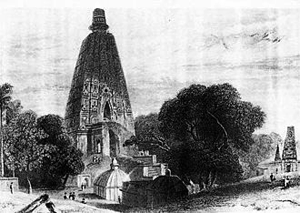
The temple as it appeared in the 1780s
After the defeat of the Palas by the Hindu Sena dynasty, Buddhism's position again began to erode and was soon followed by the conquest of Magadha by General Ikhtiar Uddin Muhammad Bin Bakhtiyar Khilji.[10] During this period, the Mahabodhi Temple fell into disrepair and was largely abandoned. During the 16th century, a Hindu monastery was established near Bodh Gaya. Over the following centuries, the monastery's abbot or mahant became the area's primary landholder and claimed ownership of the Mahabodhi Temple grounds.
In the 1880s, the-then British government of India began to restore Mahabodhi Temple under the direction of Sir Alexander Cunningham. In 1885, Sir Edwin Arnold visited the site and published several articles drawing the attention of the Buddhists to the deplorable conditions of Buddhagaya.[1] He was guided in this undertaking by Ven.Weligama Sri Sumangala[2][3] In 1891, Anagarika Dharmapala started a campaign to return control of the temple to Buddhists, over the objections of the mahant. The campaign was partially successful in 1949, when control passed from the Hindu mahant to the state government of Bihar, which established a temple management committee. The committee has nine members, a majority of whom, including the chairman, must by law be Hindus. Mahabodhi's first head monk under the management committee was Anagarika Munindra, a Bengali man who had been an active member of the Maha Bodhi Society.
Mulagandha Kuty Vihara in Sarnath
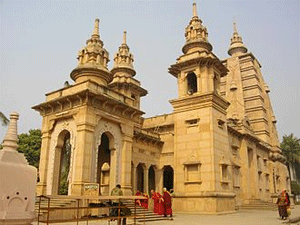
MahaBodhi Mulagandhakuti Buddhist Temple at Sarnath
Mulagandha Kuty Vihara in Sarnath is a fitting reminder of Sarnath's past glory. It is also the crowning and most glorious achievement of Anagarika Dharmapala's lifelong dedication. The construction of the Mulagandha Kuty Vihara was taken up by Anagarika Dharmapala in 1926 towards the end of his pious life. When he decided to construct a temple at Sarnath and after making the architectural plans, it was the generous Hawaiian Lady, Mary Foster who gave the first financial assistance came from his parents, brother and well-wishers. He personally supervised the constructional works. The 200 feet high magnificent temple was opened to public in 1931. Later a reputed Japanese artist Mr. Kosteu Nosu and his assistant undertook the task to decorate the temple walls with fresco paintings known famously as the Mural paintings of Mulagandha Kuty Vihara, depicting the life Events of Sakyamuni Buddha. On the opening day of the Vihara, the Buddha's relics donated to Anagarika Dharmapala by Govt. of India under the British Raj was enshrined in the temple. The Vihara, an attractive place of Buddhist worship was visited by numerous Indian and foreign dignataries and millions of pilgrims and tourists over the past decades. At the Mulagandha Kuty Vihara annual function in November, the most attractive items among the programs is the exposition of the Buddha's sacred relic. People from different countries and from the homeland visit the Vihara to homage to the sacred relic considering it as a rare and an opportune moment in their lifetime.
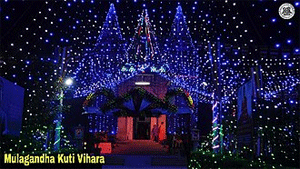
The night view of Sarnath's Mulagandha Kuty Vihara
Publications
The Maha Bodhi Society has a robust tradition of publications, spanning from Pali translations into modern Indian vernacular languages (such as Hindi) to scholarly texts and new editions of Pali works typeset in Devanagari to appeal to a Hindi-educated Indian audience. They have also published books and pamphlets in local/regional languages and dialects, sometimes in partnership with other presses.
Leadership
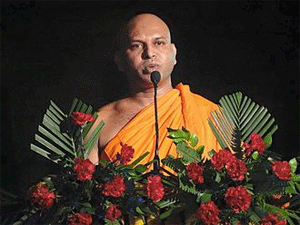
Ven. P Seewalee Thero, the current General Secretary of the Maha Bodhi Society of India at an event in Sarnath.
Most Venerable P Seewalee Thero is serving as the 12th and current General Secretary of the Maha Bodhi Society of India since 2016 and the Joint Secretaries are Venerable Kahatagollawe Medhankara Thero and Ven.Rathmalwa Sumithananda Thero.
At a meeting in September 2008, the Maha Bodhi Society passed a rule that only persons born into Buddhist families will be eligible to serve as president or as one of the vice-presidents of the Society. The outgoing president, B. K. Modi, was a Hindu; he assumed the position of patron. At the same meeting, the 14th Dalai Lama was given the new title of chief patron.[11]
See also
• Buddhism in India
References
1. Maha Bodhi Society
2. Arnold, Edwin (1906). India Revisited, London: K. Paul, Trench, Trübner
3. Dipak K. Barua (1981). “Buddha Gaya Temple: its history”, Buddha Gaya: Buddha Gaya Temple Management Committee
4. D.C. Ahir. Buddhism in Modern India. Delhi: Sri Satguru Publications, 1991. p. 17.
5. Sean O'Reilly, James O'Reilly, Pilgrimage: Adventures of the Spirit, Travelers' Tales, 2000,ISBN 1-885211-56-2 pg 81-82
6. A Close View of Encounter between British Burma and British Bengal
7. Arnold Wright, Twentieth Century Impressions of Ceylon: its history, people, commerce, industries, and resources, "Angarika Dharmapala", Asian Educational Services, 1999, ISBN 81-206-1335-X pg.119
8. C. J. Bleeker, G. Widengren, Historia Religionum, Volume 2 Religions of the Present: Handbook for the History of Religions, Brill Academic Publishers, 1971, ISBN 90-04-02598-7 pg. 453
9. Linda Learman, ed. (2005). Buddhist Missionaries in the Era of Globalizationa. University of Hawai'i Press. p. 33. ISBN 0-8248-2810-0. Retrieved 17 June 2017.
10. The Maha-Bodhi By Maha Bodhi Society, Calcutta (page 205).
11. Sengupta, Ratnottama (September 28, 2008).Now, Hindus can't head Mahabodhi Society Times of India
External links
• Mahabodhi Society
• Mahabodhi Society, Bangalore
by Wikipedia
Accessed: 4/1/19
NOTICE: THIS WORK MAY BE PROTECTED BY COPYRIGHT
YOU ARE REQUIRED TO READ THE COPYRIGHT NOTICE AT THIS LINK BEFORE YOU READ THE FOLLOWING WORK, THAT IS AVAILABLE SOLELY FOR PRIVATE STUDY, SCHOLARSHIP OR RESEARCH PURSUANT TO 17 U.S.C. SECTION 107 AND 108. IN THE EVENT THAT THE LIBRARY DETERMINES THAT UNLAWFUL COPYING OF THIS WORK HAS OCCURRED, THE LIBRARY HAS THE RIGHT TO BLOCK THE I.P. ADDRESS AT WHICH THE UNLAWFUL COPYING APPEARED TO HAVE OCCURRED. THANK YOU FOR RESPECTING THE RIGHTS OF COPYRIGHT OWNERS.
Maha: Sinhalese maha large, great, from Sanskrit mahat.
-- Maha, by Merriam Webster
Bodhi: Early 19th century bodhi was translated as "intelligence". The term "enlighten" was first being used in 1835, in an English translation of a French article, while the first recorded use of the term 'enlightenment' is credited ... to the Journal of the Asiatic Society of Bengal (February, 1836). In 1857 The Times used the term "the Enlightened" for the Buddha in a short article, which was reprinted the following year by Max Müller.[17]
-- Enlightenment in Buddhism, by Wikipedia
Total Information Awareness (TIA) was a mass surveillance program of the United States Information Awareness Office that began during the 2003 fiscal year. It operated under this title from February until May 2003, before being renamed as the Terrorism Information Awareness.
-- Total Information Awareness, by Wikipedia
In the summer of 1952... Tibet was more inaccessible than ever...One notable exception was the unique window provided by the princely state of Sikkim...
Beginning in 1947 and continuing for the next three years, its royals scrambled to salvage some form of autonomy that would safeguard their exalted status...
The job of negotiating with the Indians went to the prince's son and heir apparent, Palden Thondup...
The result was a December treaty whereby the protectorate of Sikkim was free to manage domestic matters but allowed India to regulate its foreign affairs, defense, and trade...
Though prohibited from making independent foreign policy, they believed that it was still within their right to retain a degree of international personality. This held obvious appeal for the United States, which appreciated Sikkim's unique perspective on Himalayan events, on account of its royals being related by blood and marriage to the elite in neighboring Bhutan and Tibet...In the spring of 1951, the U.S. consulate in Calcutta gingerly tested the waters. The Chinese had already invaded Kham, and Larry Dalley, a young CIA officer who had arrived in the city the previous fall under cover of vice consul, was eager to collect good intelligence on events across the border. He knew that two members of Sikkim's royal family frequented Calcutta and would be good sources of information.
The first, Pema Tseudeun, was the older sister of the crown prince. Popularly known by the name Kukula, she was the stunning, urbane archetype of a Himalayan princess. Her contact with American officials actually dated back to 1942, when she had been in Lhasa as the teenage wife of a Tibetan nobleman. OSS officers Tolstoy and Dolan had just arrived in the Tibetan capital that December and were preparing to present a gift from President Franklin Roosevelt to the young Dalai Lama. The gift was in a plain box, and the two Americans were scrambling to find suitable wrapping. "I came forward," she recalls, "and donated the bright red ribbon in my hair." [During his stay in Lhasa, OSS officer Dolan befriended Kukula's sister-in-law and fathered her child.]
For the next eight years, Kukula had it good. Married into the powerful Phunkang family (her father-in-law was a cabinet official), she now had considerable holdings in Lhasa. After the Chinese invasion of Kham, however, all was in jeopardy. Leaving many of her possessions back in Tibet, she fled to the safety of Sikkim. There she became a close adviser to the crown prince, accompanying her brother to New Delhi that December to finalize their state's treaty with India.
The second royal in Calcutta, Pema Choki, was Kukula's younger sister. Better known as Princess Kula, she was every bit as beautiful and sophisticated as her sibling. Kula was also married to a Tibetan of high status; her father-in-Iaw, Yutok Dzaza, had been a ranking official at the trade mission in Kalimpong. Both Kukula and Kula were regulars on the Indian diplomatic circuit. "They came to many of the consulate's social functions," remembers Nicholas Thacher, "and were known for their ability to perform all of the latest dance numbers."
Not all of that contact, CIA officer Dalley determined, was social. After arranging for a meeting with Princess Kukula at his apartment, he asked her if she thought the Tibetans might need anything during their current crisis. Kukula suggested that they could use ammunition and said that she would bring a sample of what they needed to their next meeting. True to her word, the princess appeared at Dalley's apartment bearing a round for a British Lee-Enfield rifle. She also mentioned that waves of Tibetan traders came to India almost quarterly to get treatment for venereal disease (a scourge in Tibet) and to pick up food shipments for import. Particularly popular at the time were tins of New Zealand fruits packed in heavy syrup.
Based on this information, Dalley devised a plan to substitute bullets for the fruit. He went as far as pouching Kukula's bullet and a sample tin label to CIA headquarters -- all to no avail. "They laughed at the scheme," he recalls.
Later that spring, the U.S. consulate in Calcutta again turned to the Sikkimese royals for help. At the time, the Dalai Lama was holed up in the border town of Yatung, and CIA officer Robert Linn was brainstorming ways of facilitating indirect contact with the monarch. Two of those he asked to assist in passing notes were Kukula and Kula. Although the Tibetan leader ultimately elected not to go into exile, it was not for want of trying on the part of the princesses.
One year later, Sikkim's royals once more proved their willingness to help. In June 1952, Kukula approached the consulate with an oral message from the Dalai Lama. She had just returned from a visit to her in-laws in Lhasa, and although she had not personally seen the Dalai Lama, she had been given information from Kula's father-in-Iaw, Yutok Dzaza, who had been in Lhasa at the same time, circulating among senior government circles. [Back in September 1951, Yutok Dzaza, a former official at the Tibetan trade office in Kalimpong, had been brought down to the consulate in Calcutta and shown Ambassador Henderson's last-ditch appeal to the Dalai Lama written on U.S. embassy letterhead. Yutok took notes from the letter and then went to Lhasa, where he met several senior government officials. He also met with one of the Dalai Lama's older brothers, Lobsang Samten. It was the information gathered from these sources that he passed to Princess Kukula.] Kukula quoted the Dalai Lama as saying that when the time was propitious for liberation, he hoped the United States would give material aid and moral support. Kukula also passed observations about food shortages in Lhasa and about the desperate conditions of the vast majority of Chinese troops in that city.
To maintain the flow of such useful information, the consulate continued its discreet courtship of the Sikkimese sisters. Part of the task fell to Gary Soulen, the ranking Foreign Service officer in Calcutta. In September 1952, Soulen obtained Indian approval to visit Sikkim for a nature trek. Venturing as far as the Natu pass on the Tibetan frontier, Princess Kukula accompanied him on the trip and imparted more anecdotes about the situation in Lhasa.
CIA officials, too, were looking to make inroads. Kenneth Millian, who replaced Larry Dalley in October 1952 under cover as vice consul, counted the Sikkimese as one of his primary targets. By that time, however, the Indians were doing everything in their power to obstruct contact. On one of the rare occasions when he got permission to visit the Sikkimese capital of Gangtok, for example, New Delhi leaked a false report to the press that the American vice president -- not vice consul -- was scheduled to make an appearance. As a result, entire villages turned out expecting to see Richard Nixon. "Discreet contact," lamented Millian, "became all but impossible."
Occasional trysts with the Sikkimese were conducted by another CIA officer in Calcutta, John Turner. Born of American parents in India, Turner spent his formative years attending school in Darjeeling. He then went to college in the United States, followed by a stint in the army and induction into the agency in 1948. For his first overseas CIA assignment, he was chosen in May 1952 to succeed Robert Linn as the senior CIA officer in Calcutta. Given his cultural background and fluency in Hindi, Turner was well suited for the job...
The Sikkimese, Turner found, needed no prompting to maintain contact "They offered us tidbits of intelligence to try and influence U.S. policy," he concluded....
[T]he prince would pass Turner relevant information about Tibet. One such meeting took place in the spring of 1954 immediately after the crown prince's return from a trip to Lhasa. While in the Tibetan capital, the prince had spoken with the Dalai lama, whom he found unhappy but resigned to his fate. Even more revealing, the Chinese had feted their Sikkimese guest by showing off their new Damshung airfield north of Lhasa and had motored him along a fresh stretch of road leading into Kham. Turner found the debriefing so informative that he recorded the entire session and sent a voluminous report back to Washington...
As this was taking place, the Dalai Lama faced mounting challenges on the political front. While in Beijing during 1955, he had been informed by Mao that a Preparatory Committee for the Autonomous Region of Tibet (PCART) would be formed to codify Tibet's status under the seventeen-point agreement. The committee was inaugurated in Lhasa during April 1956, with the Dalai Lama as chairman; the majority of PCART members, however, were either directly or indirectly named by the PRC. In this way, Beijing effectively bypassed both Tibet's cabinet and the National Assembly.
Between Beijing's PCART ploy and news filtering into the capital of Chinese brutality in the east, the Dalai Lama was fast reaching his breaking point by mid-1956. Just shy of his twenty-first birthday, he had already entertained thoughts of withdrawing from all secular life. It was at this critical juncture that his earlier foreign guest, the crown prince of Sikkim, made a return visit to Lhasa.
The crown prince was on more than a courtesy call…
Disturbed by Beijing's lack of restraint, Nehru suddenly developed some backbone. By coincidence, the 2,500-year anniversary of the birth of Buddha was to be celebrated during the fourth lunar month of 1957. Special events to mark that date, known as the Buddha Jayanti, were scheduled across India beginning in late 1956. If the Dalai Lama could be enticed to travel to India for the occasion, New Delhi felt that this would symbolically underscore its interest in the well-being of Tibet and its leader. Because he already had good rapport with the Dalai Lama, and because he was president of the Indian Maha Bodhi Society (an organization that represented Buddhists across the Indian subcontinent), the crown prince was tasked by Nehru to deliver the invitation.
Upon receiving his Sikkimese guest and hearing the news, the Dalai Lama was ecstatic. For a Tibetan, a pilgrimage to India -- especially one that coincided with the Buddha Jayanti -- had all the connotations of a visit to the holy sites of Rome or Mecca. But more important, it would allow him to air his concerns directly to Nehru and perhaps offset Chinese influence. Perhaps, too, he could finally make good on his earlier contemplation of exile. Some of his minders, in fact, were convinced that the latter could be arranged, despite the fact that no nation, India included, had given any solid guarantee of asylum. [In his memoirs, the Dalai Lama does not mention his desire to seek exile during the crown prince's 1956 visit to Lhasa.]
Having delivered the invitation, the crown prince returned to India and on 28 June made his way to the U.S. consulate in Calcutta. Speaking directly with the senior diplomat, Consul General Robert Reams, he noted the apparent desire of the Dalai lama to leave his country. The crown prince also relayed stories reaching Lhasa about horrific fighting taking place in eastern Tibet, offering Washington hearsay evidence that anti-Chinese resistance had escalated into armed rebellion. Noting the apparent lack of weapons among the insurgents, the prince astutely suggested channeling arms from East Pakistan (presumably via Sikkim) to Tibet. And in a more fanciful departure, he wondered aloud if the United States could "exfiltrate" Tibetans from Burma and Thailand -- ostensibly while on religious pilgrimages -- and give them artillery and antiaircraft training.
-- The CIA's Secret War in Tibet, by Kenneth Conboy and James Morrison
[O]n the 19th of July, I took passage on an English steamer, the Lightning, which, after calling at Penang, brought me to Calcutta on the 25th of the month. Placing myself under the care of the Mahābodhi Society of Calcutta, I spent several days in that city, in the course of which I learned from Mr. [Charu] Chandra Bose, a Secretary of the Society, that I could not do better for my purpose than to go to Darjeeling, and make myself a pupil of Rai Bahadur Sarat Chandra Das, who, as I was told, had some time before spent several months in Tibet, and was then compiling a Tibetan-English dictionary at his country house in Darjeeling. Mr. Chandra Bose was good enough to write a letter of introduction to the scholar at Darjeeling in my favor, and, with it and also with kind parting wishes of my countrymen in the city and others, I left Calcutta on August 2nd, by rail.
***
About a fortnight after my arrival in Malba I received a letter from Rai Sarat Chandra Das, through a trader of Tukje, with whom I had become acquainted while in Tsarang, and to whom I had entrusted a letter to my friend at Darjeeling, as well as others to my folks at home, on the occasion of his going down to Calcutta on business. Along with his letter Sarat Chandra Das sent me a number of the Mahabodhi Society’s journal, which contained an account of an unsuccessful attempt by a Buddhist of my nationality to enter Tibet, and a well-meant note of his in pencil to the effect that I must not lose my life by exposing myself to too much danger. So far so good; but next something which was not so good happened. The Tukje man, my whilom messenger, had apparently formed an opinion of his own about my personality, and set the quiet village of Malba astir with rumors about myself. Chandra Das was an official of the English Government, with a salary of 600 rupees a month, and, as such, a very rare personage among Bengālīs; and it was with this person that I corresponded; ergo, the Chinese Lama (myself) must be a British agent in disguise, with some secret mission to execute. So went the rumor, and the public opinion of Malba had almost come to the conclusion that it was undesirable to permit such a suspicious stranger in the village, when Adam Naring, who by that time had come home, sought to speak to me in secret, with indescribable fear written on his face. Poor honest soul! What he said to me, when by ourselves, was of course to the effect that if there were any truth in the rumor, he and his folks would be visited with what punishment heaven only knew. I had expected this for some time past, and had made up my mind how to act as soon as Naring approached me on the subject. I turned round and, looking him squarely in the face, said: “If you promise me, under oath, that you will not divulge for three full years to come what I may tell you, I will let you into my secret; but if you do not care to do so, we can only let the rumor take care of itself, and wait for the Nepāl Government to take any steps it may deem fit to take.” I knew Adam Naring was a man of conscience, who could be trusted with a secret: he signified his willingness to take an oath, and I placed before him a copy of the sacred Scripture and obtained from him the needed promise.
Producing next my passport, given me by the Foreign Office in Japan, which had on it an English as well as other translations of the Japanese text, I showed it to my host, who understood just enough English to follow out the spelling of some words in that language, and explained to him the real object of my journey into Tibet. I did more. I said to him that now that he possessed my secret, he was welcome to make of it what use he liked; but that I believed him to be a true and devoted Buddhist, and that it behoved him well to assist me in my enterprise by keeping silence, for by so acting he would be promoting the cause of his own religion.
-- Three Years in Tibet, by Shramana Ekai Kawaguchi
In Calcutta, then not only the political but the intellectual metropolis of India, he stayed at the house of a Bengali Theosophist, Babu Neel Comal Mookerjee, who became a lifelong friend of the Anagarika and a loyal supporter of his mission. Together they visited various places of interest in the city, including the Indian Museum and the Royal Asiatic Society of Bengalwhere, to his great delight, Dharmapala made the acquaintance of Sarat Chandra Das, famous for his travels in Tibet, and for his knowledge of the language and religious literature of that country. He also won the friendship of Narendra Nath Sen, the editor of the Indian Mirror, a Theosophist whose eloquent pen was for many years ready to plead for the revival of Buddhism in India.
**
The World’s Parliament of Religions which was held in Chicago in 1893 was one of the most important and characteristic events of the late nineteenth century. Fifty years earlier the influence of Christian dogma and popular ignorance even of the existence of the great oriental religions would have rendered such a gathering an impossibility. As it was, the organizers of the Parliament were accused by a missionary in China of “coquetting with false religions” and “plannings treason against Christ”. Fifty years later, political unrest and widespread indifference to religion would either have made the venture abortive or reduced it to little more than an anthropological curiosity. In the closing decade of the last century, however, the time was ripe for the presentation of the diverse religions of the world from a common platform not by scholars but by men who actually followed them, and when the special Committee appointed for the purpose by the President of the Columbian Exposition circulated their plans the idea of a World’s Parliament of Religions met with general acceptance. The Chairman of the Committee, Dr. J. R. Barrows, who had received copies of the Maha Bodhi Journal, entered into correspondence with Dharmapala, and in the end invited him to Chicago as the representative of the Southern Buddhist Church. With his usual modesty, Dharmapala doubted his ability to expound the Dharma before such a distinguished gathering, but his friends were insistent that he should go, one of them declaring that far more important than any amount of scholarship was the living conviction of the truth of the Buddha’s Word. Such a conviction was the breath of Dharmapala’s life. After much consideration he decided to accept the invitation, reflecting that it would enable him to visit Japan and China in the interests of the Society without putting any additional strain on its resources. Only Col. Olcott was against the trip, roundly declaring that with so much work to be done in India it was a waste of time. However, Dharmapala was by this time accustomed to deciding things for himself, and in the end the Colonel’s opposition collapsed and he promised to write to Mrs. Besant, who was also attending the Parliament, asking her to keep an eye on his young colleague.
After entrusting the Journal to Sarat Chandra Das, Dharmapala left Calcutta at the beginning of July, and on the evening of the day of his arrival in Colombo was presented with a purse by the Ceylon Theosophical Society.
***
In May 1892 the Society launched its monthly Journal, in which was recorded, besides the activities of the Society, all that was being done for the propagation of the religion, together with a detailed account of the Buddhist literature in Europe and Asia. The publication of the Journal was conducted first from 20/1, Gangadhar Babu Lane, Bowbazar, — which house had been secured by the Burmans for residence of Burmese pilgrims, — and then from 2, Creek Row. The Journal was edited by Mr. Dharmapala, and during his absence, when he went to America, it was managed by Sarat Chandra Das and Charu Chandra Bose. Among the Society's active sympathizers were Neel Comal Mookerjee and his son Nirod Nath Mookerjee, at whose house Mr. Dharmapala often stayed for long periods, and Narendra Nath Sen, all of whom were always ready to extend to him a helping hand.
***
Anagarika Dharmapala freely acknowledged the help obtained by him from his Bengali friends and well-wishers in the organisation of the Maha Bodhi Society. He mentioned particularly the following persons: Narendra Nath Sen, Neel Comal Mookerjee, Neerod Nath Mookerjee, Rai Bahadur Sarat Chandra Das, Ras Biliary Mookerjee of Uttarpara, Jadu Nath Mazumdar of Jessore, Maharaja Sir Jatindra Mohan Tagore, Ananda Mohan Roy of Bhowanipore, Nanda Kisor Lall as Hony. Legal Adviser, Durga Sankar Bhattacharya and Hari Das Chatterji of Gaya, Babu Saligram Singh, Prof. Satis Chandra Vidyabhusana, Mahamahopadhyaya Neelmoni Mookerji and Babu Paranieswar Lall (see Dec. 1901 and Jan. 1902).
***
In 1917 passed away Rai Bahadur Sarat Chandra Das, who was associated closely with the Maha Bodhi Society in various matters, and who had rendered valuable services to the Society.
-- Maha Bodhi Society of India: Diamond Jubilee Souvenir, 1891-1951, by Devapriya Valisinha, Maha Bodhi Society
MAHA BODHI LITERARY SECTION.
In accordance with the scheme already set forth for the revival of the study of Pali Literature, the Maha-Bodhi Society has decided to open a Literary Section, the object of which will be (i) to transliterate the Pali Buddhist works into Devanagari and the other vernaculars of the country, together with their translations, (ii) to bring out popular editions of important Buddhist texts, with copious notes and explanations so that they may be read and understood by the people of this country and also (iii) to open a class for the study of Pali Literature (which will be converted into a regular Institution afterwards) at 2, Creek Row, where regular instructions will be given to the students who are willing to join. Pali is one of the classical languages of India, whose history can be traced so far back as six hundred years B.C. While every attempt has been made to revive and spread the Sanskrit language both by the people and the Government, we have, up to the present, neglected Pali, which has been the spoken language of India from remote antiquity and which for centuries together flourished in the whole of Upper India as the principal dialect which the people wrote and spoke. The subject was studied and cultivated in the ancient Universities of Nalanda, Takkhasila, Udanta-pu-ri and Vikramsila, and patronised at the Courts of the different Kingdoms.
Though we have done nothing as yet to revive and bring to light this important literature which is contained in the Pali language, thanks to the exertions of the noble band of Orientalists, the subject has been fully appreciated and is being studied in the Universities of England, France, Germany, Russia and America. Pali literature has been almost a sealed literature to us. Our knowledge of the History of India is not at all complete without the knowledge of Pali. For brilliant records of the achievements of kings and princes, the interesting history of the manners and customs of the people, and a faithful account of the internal Government, are all to be met in this ancient literature. The language is important alike to the student of comparative religion, historian and philologist. Its study will at once reveal the glory of ancient Indian wisdom. The Society has undertaken the publication in Devanagari of Kaccayana’s Pali Grammar by Pandit Satish Chandra Vidhyabhushan, M. A., and Dhammapada and Suttanipata by Babu Charu Chandra Bose.
The University of Calcutta recognises Pali as one of the second languages in the Entrance, First Arts, B. A . and M. A. Examinations ....
Those who may be willing to take up this important subject of study in any of their University Examinations are at once requested to communicate with the undersigned. Instructions will be given to lay students as well as to University Examination candidates. For the convenience of the latter the class will be held daily, (Sundays excepted) from 5 to 6 P. M. The tuition fee will be Rs. 2 per mensem for the students of the College Classes and Re. 1 for the students of the School Department. Competent Pali scholars will be in charge of the classes and the whole work will be supervised by a Committee.
To carry out the foregoing objects, viz., undertaking the translation of important Pali works and bringing out popular editions of rare Buddhist books, and also establishing an institution where every facility may be given for the study of this classical language, would require at least two thousand rupees annually. The work will be purely of an unsectarian character. The chief aim of the Maha-Bodhi Literary Section is to give the educated public an opportunity to come in contact with this splendid literature which is an inexhaustible mine of knowledge and an immortal legacy handed down to us by the Sages of old. We ask for the help and co-operation of all who are interested in this work both in this country and in foreign lands. Donations for the furtherance of the cause w ill be gratefully received, and acknowledged in the Maha-Bodhi Journal. All communications on the subject should be addressed to the undersigned.
RAS BIHARI MUKARJI (UTTARPARA), BENGAL,
Honorary Secretary,
Maha-Bodhi Literary Section.
-- Supplement to the Theosophist, September 1901.
Sarat Chandra Das was a distinguished student of Sanskrit and Tibetan (and a British intelligence agent) who made two trips to the Tashilunpo monastery and returned with hundreds of Buddhist manuscripts. Das founded the Buddhist Text Society in Calcutta with Dharmapala, and when he engaged 2 Creek Row, it served as headquarters for the Maha Bodhi Society, the Theosophical Society, and the Buddhist Text Society (Diary, June 30, 1904). Other Bengali scholars -- Charu Chandra Bose and Satis Chandra Vidyabhushan -- shared an interest in Buddhism and became members of the Maha Bodhi Society. Leaving Calcutta for his trip to the Parliament of Religions, Dharmapala left the place "in the hands of Sarat babu and Charu babu" (Diary, February 14, 1893).
-- Rescued from the Nation: Anagarika Dharmapala and the Buddhist World, by Steven Kemper
The Maha Bodhi Society is a South Asian Buddhist society founded by the Sri Lankan Buddhist leader Anagarika Dharmapala and the British journalist and poet Sir Edwin Arnold. The organization's self-stated initial efforts were for the resuscitation of Buddhism in India, and restoring the ancient Buddhist shrines at Bodh Gaya, Sarnath and Kushinara.[1][2][3]
Although some Indians had remained culturally Buddhist for centuries after the decline of Buddhist philosophy, they did not self-identify as "Buddhist". The Maha Bodhi Society renewed interest in Buddhism, and spawned the Ladakh Buddhist Association, All Assam Buddhist Association, and Himalayan Buddhist Society, as well as laying the grounds for the Dalit Buddhist movement.[4]

Headquarters, Maha Bodhi Society of India, Kolkata. October 2014.

Interior of the Dharmarajika Chetiya Vihara of the Mahabodhi Society, officially opened 26th Nov 1920.
Origins
In 1891, while on pilgrimage to the recently restored Mahabodhi Temple at Bodh Gaya, the location where Siddhartha Gautama (the Buddha) attained enlightenment, Anagarika Dharmapala had experienced a shock to find the temple in the hands of a Saivite priest, the Buddha image transformed into a Hindu icon and Buddhists barred from worship as a result of which he began an agitation movement.[5] Prior to that, in 1885 Sir Edwin Arnold visited the site and published several articles drawing the attention of the Buddhists to the deplorable conditions of Buddhagaya.[1][2][3] The Buddhist renaissance inaugurated by Anagarika Dharmapala through his Mahabodhi Movement has also been described as "conservative" for it considered Muslim conquest in the Indian subcontinent responsible for the decay of Buddhism in India, in the then current mood of Hindu-Buddhist brotherhood.[6]

Lawrence Dundas, Lord Ronaldshay and Governor of Bengal (1917-22) presents the Buddha relic which had been discovered 1892 in Battiporolu to Ashutosh Mukherjee, then Vice Chancellor of Calucatta University, acting Chief Justice of the Calcutta High Court and President of the Mahabodhi Society, Calcutta to be enshrined in the newly opened Dharmarajika Chetiya Vihara on College Square. Morning of 26th Nov. 1920 on the steps of Government House, Calcutta.
The Mahabodhi Society at Colombo was founded in 1891 but its offices were moved to Calcutta the following year. One of its primary aims was the restoration of the Mahabodhi Temple at Bodh Gaya, the chief of the four ancient Holy sites to Buddhist control.[7][8] To accomplish this Dharmapala initiated a lawsuit against the Brahmin priests who had held control of the site for centuries.[7][8] After a protracted struggle this was successful with the partial restoration of the site to the management of the Maha Bodhi Society in 1949.[7][8]
Maha Bodhi Society branches have been established in several countries, most significantly in India and Sri Lanka. A United States branch was founded by Dr. Paul Carus in Chicago.[9] There is also a Maha Bodhi Society of Bangalore, founded by Acharya Buddharakkhita in 1956, which is not a part of or tied to the Maha Bodhi Society of India or Sri Lanka.[citation needed]
The Mahabodhi Temple

The temple as it appeared in the 1780s
After the defeat of the Palas by the Hindu Sena dynasty, Buddhism's position again began to erode and was soon followed by the conquest of Magadha by General Ikhtiar Uddin Muhammad Bin Bakhtiyar Khilji.[10] During this period, the Mahabodhi Temple fell into disrepair and was largely abandoned. During the 16th century, a Hindu monastery was established near Bodh Gaya. Over the following centuries, the monastery's abbot or mahant became the area's primary landholder and claimed ownership of the Mahabodhi Temple grounds.
In the 1880s, the-then British government of India began to restore Mahabodhi Temple under the direction of Sir Alexander Cunningham. In 1885, Sir Edwin Arnold visited the site and published several articles drawing the attention of the Buddhists to the deplorable conditions of Buddhagaya.[1] He was guided in this undertaking by Ven.Weligama Sri Sumangala[2][3] In 1891, Anagarika Dharmapala started a campaign to return control of the temple to Buddhists, over the objections of the mahant. The campaign was partially successful in 1949, when control passed from the Hindu mahant to the state government of Bihar, which established a temple management committee. The committee has nine members, a majority of whom, including the chairman, must by law be Hindus. Mahabodhi's first head monk under the management committee was Anagarika Munindra, a Bengali man who had been an active member of the Maha Bodhi Society.
Mulagandha Kuty Vihara in Sarnath

MahaBodhi Mulagandhakuti Buddhist Temple at Sarnath
Mulagandha Kuty Vihara in Sarnath is a fitting reminder of Sarnath's past glory. It is also the crowning and most glorious achievement of Anagarika Dharmapala's lifelong dedication. The construction of the Mulagandha Kuty Vihara was taken up by Anagarika Dharmapala in 1926 towards the end of his pious life. When he decided to construct a temple at Sarnath and after making the architectural plans, it was the generous Hawaiian Lady, Mary Foster who gave the first financial assistance came from his parents, brother and well-wishers. He personally supervised the constructional works. The 200 feet high magnificent temple was opened to public in 1931. Later a reputed Japanese artist Mr. Kosteu Nosu and his assistant undertook the task to decorate the temple walls with fresco paintings known famously as the Mural paintings of Mulagandha Kuty Vihara, depicting the life Events of Sakyamuni Buddha. On the opening day of the Vihara, the Buddha's relics donated to Anagarika Dharmapala by Govt. of India under the British Raj was enshrined in the temple. The Vihara, an attractive place of Buddhist worship was visited by numerous Indian and foreign dignataries and millions of pilgrims and tourists over the past decades. At the Mulagandha Kuty Vihara annual function in November, the most attractive items among the programs is the exposition of the Buddha's sacred relic. People from different countries and from the homeland visit the Vihara to homage to the sacred relic considering it as a rare and an opportune moment in their lifetime.

The night view of Sarnath's Mulagandha Kuty Vihara
Publications
The Maha Bodhi Society has a robust tradition of publications, spanning from Pali translations into modern Indian vernacular languages (such as Hindi) to scholarly texts and new editions of Pali works typeset in Devanagari to appeal to a Hindi-educated Indian audience. They have also published books and pamphlets in local/regional languages and dialects, sometimes in partnership with other presses.
Leadership

Ven. P Seewalee Thero, the current General Secretary of the Maha Bodhi Society of India at an event in Sarnath.
Most Venerable P Seewalee Thero is serving as the 12th and current General Secretary of the Maha Bodhi Society of India since 2016 and the Joint Secretaries are Venerable Kahatagollawe Medhankara Thero and Ven.Rathmalwa Sumithananda Thero.
At a meeting in September 2008, the Maha Bodhi Society passed a rule that only persons born into Buddhist families will be eligible to serve as president or as one of the vice-presidents of the Society. The outgoing president, B. K. Modi, was a Hindu; he assumed the position of patron. At the same meeting, the 14th Dalai Lama was given the new title of chief patron.[11]
See also
• Buddhism in India
References
1. Maha Bodhi Society
2. Arnold, Edwin (1906). India Revisited, London: K. Paul, Trench, Trübner
3. Dipak K. Barua (1981). “Buddha Gaya Temple: its history”, Buddha Gaya: Buddha Gaya Temple Management Committee
4. D.C. Ahir. Buddhism in Modern India. Delhi: Sri Satguru Publications, 1991. p. 17.
5. Sean O'Reilly, James O'Reilly, Pilgrimage: Adventures of the Spirit, Travelers' Tales, 2000,ISBN 1-885211-56-2 pg 81-82
6. A Close View of Encounter between British Burma and British Bengal
7. Arnold Wright, Twentieth Century Impressions of Ceylon: its history, people, commerce, industries, and resources, "Angarika Dharmapala", Asian Educational Services, 1999, ISBN 81-206-1335-X pg.119
8. C. J. Bleeker, G. Widengren, Historia Religionum, Volume 2 Religions of the Present: Handbook for the History of Religions, Brill Academic Publishers, 1971, ISBN 90-04-02598-7 pg. 453
9. Linda Learman, ed. (2005). Buddhist Missionaries in the Era of Globalizationa. University of Hawai'i Press. p. 33. ISBN 0-8248-2810-0. Retrieved 17 June 2017.
10. The Maha-Bodhi By Maha Bodhi Society, Calcutta (page 205).
11. Sengupta, Ratnottama (September 28, 2008).Now, Hindus can't head Mahabodhi Society Times of India
External links
• Mahabodhi Society
• Mahabodhi Society, Bangalore
